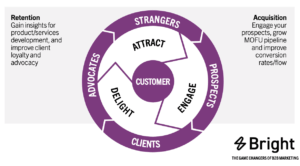Being a customer-centric business in a recession should not be understated. Customer centricity, with a strong focus on audience development principles (building and nurturing a community of loyal supporters and customers around your brand), is a winning strategy. Building trust with your client and prospect community will help you identify and test new ways to market your products and services.
What does that actually mean in practice?
During a recession, it’s time to revisit the importance of customers within your marketing model. Marketers typically use the funnel approach, focused on attracting new leads at the top and working down to converting into customers at the bottom, which inevitably puts customers low down on the list.
In contrast, the flywheel approach puts customers at the centre, surrounded by proactive client service, marketing and sales support. Creating a holistic view of your clients by creating a cross-functional approach to your sales, marketing and client support really helps create a frictionless and positive client experience. This means all the teams working across your client touchpoints need to learn to work together to break down silos and make sure the client is always put first.
The flywheel model shifts teams from an inward focus (we want to tell prospects and customers what we want to) to a customer-centric focus (we want to listen to prospects and customers and deliver remarkable experiences), enhancing a prospect’s journey even after they’ve matured into a customer.

Customer centricity flywheel
This model helps businesses take advantage of how customers purchase today – through their network, third-party review sites and other peer networks (e.g., social media).
Customer-centric companies are 60% more profitable compared to companies that are not.
Putting the customer at the heart of your marketing is a key principle of agile marketing and encourages teams to think and prioritise marketing efforts to maximise where and how you add value to your customers. Becoming more customer-centric pays off – keeping a loyal customer is cheaper than net new, and a net new customer that feels valued can become a brand advocate and embark on a continued partnership in the long term.
“Changing our approach to be more customer-centric our client satisfaction rates increased by 10%, which then resulted in a 5% increase in yearly spend.” – Agile Marketing Manifesto

